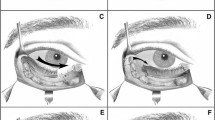Abstract
The authors present the anatomical findings that have made an easier approach to composite rhytidectomy possible. The lower lateral border of the orbicularis oculi muscle (OOM) overlies the zygomaticus major muscle (ZMM), the upper third of which tightly adheres to the malar bone. The OOM is innervated throughout over its circumference by a plexus of small facial nerve branches. From its deeper surface, the ZMM is innervated by two to four branches in its upper third and middle third. These branches are jeopardized in an extended sub-SMAS dissection as this tends to go deep into the ZMM. The malar fat pad is superficial to the SMAS layer that invests the zygomaticus and levator labii muscles and, with age, tends to slide downward, medially deepening the nasolabial folds. An extended dissection beyond the OOM tends to remain superficial to the upper part of the ZMM, zygomaticus minor, and levator muscle complex. We have found that extending the suborbicularis dissection inferiorly and laterally offers three major advantages: (1) The correct deep subcutaneous plane just above the ZMM, zygomaticus minor muscle, and levator complex can be found easily, leaving all of the fat attached to the skin. The only structures at risk are some minor motor branches to the OOM that can be divided without any morbidity because of the extensive plexiform innervation. (2) A. change in the plane from a sub-SMAS to a deep subcutaneous dissection over the ZMM can be made easily and safely by means of separate dissections for the lateral and the medial parts of the cheek with the ZMM acting as a watershed area; the two dissections can then be united under direct vision avoiding any trauma to the muscle or motor nerve branches. (3) The correct repositioning and deep fixation of the malar fat pad is easily performed. This approach has been applied successfully in 19 patients without any complications. We believe that the correct performance of this technical modification, which provides the same composite flaps as those described by Hamra, is easier and may be safer than the standard lateral approach.
Similar content being viewed by others
References
Barton FE: Rhytidectomy and the nasolabial folds. Plast Reconstr Surg 90: 601, 1992
Freilinger G, Gruber H, Happak W, Pechmann U: Surgical anatomy of the mimic muscle system and the facial nerve: importance for reconstructive and aesthetic surgery. Plast Reconstr Surg 80: 686, 1987
Furnas DW: The retaining ligaments of the cheek. Plast Reconstr Surg 83: 11, 1989
Hamra ST: The deep plane rhytidectomy. Plast Reconstr Surg 86: 53, 1990
Hamra ST: Composite rhytidectomy. Plast Reconstr Surg 90: 1, 1992
Hamra ST: Repositioning the orbicularis oculi muscle in the composite rhytidectomy. Plast Reconstr Surg 90: 11, 1992
Hamra ST: Composite rhytidectomy. St. Louis: Quality Medical Publishing, 1993
Owsley JQ: Lifting the malar fat pad for correction of prominent nasolabial folds. Plast Reconstr Surg 91: 463, 1993
Mendelson BC: Correction of the nasolabial fold: Extended SMAS dissection and periosteal fixation. Plast Reconstr Surg 89: 822, 1992
Stuzin JM, Baker TJ, Gordon HL: The relationship of the superficial and deep facial fascias. Relevance to rhytidectomy and aging. Plast Reconstr Surg 89: 441, 1992
Terzis JK, Daigle JP: New data on facial nerve anatomy and electrophysiology for safe facial aesthetic surgery. In: Hinderer UT (ed): Proceedings of the Xth Congress of ICPRS, Plastic Surgery 1992. Elsevier: Amsterdam, 1992, vol I, pp 455–457
Author information
Authors and Affiliations
Rights and permissions
About this article
Cite this article
Tremolada, C., Fissette, J. & Candiani, P. Anatomical basis for a safe and easier approach to composite rhytidectomy. Aesth. Plast. Surg. 18, 387–391 (1994). https://doi.org/10.1007/BF00451345
Issue Date:
DOI: https://doi.org/10.1007/BF00451345



